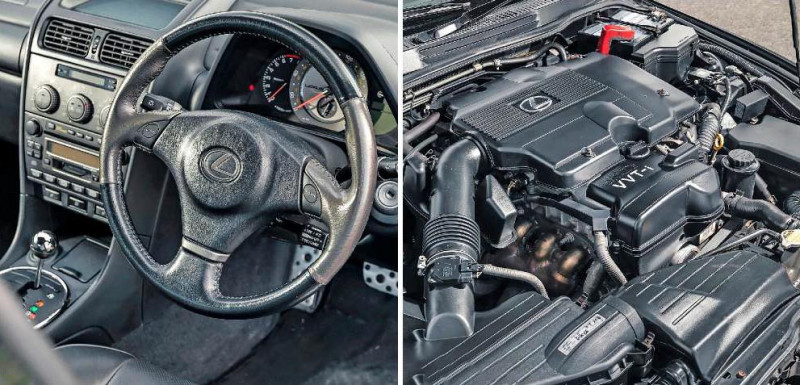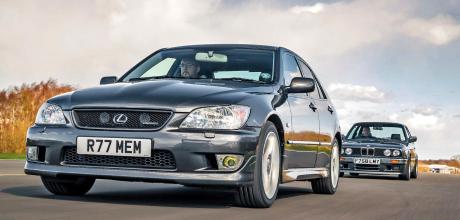2002 Lexus IS300 XE1
Our final contender is both significant and poignant. Not only is it our only Japanese offering in this test, but it’s also the model that reflects a change in buying habits that might well spell the death knell of the sports saloon altogether. The third and current generation of the Lexus IS300 will be its final iteration, because around 80 per cent of new drivers prefer the elevated driving position of the company’s SUVs.
Lexus might have been late to the sports saloon party, but it made up for it by making an absolute stonker. The IS300 is the 3.0-litre version of the first-generation IS200 XE1 – the base model launched in Japan as the Toyota Altezza in 1998. The IS200 landed in the UK a year later, while the IS300 didn’t reach Britain until 2001 – and only then in miniscule numbers. Developed with the intention of taking on the BMW 3 Series, Audi A4 and Mercedes- Benz C-Class it had to be a compact, entry-level luxury saloon that was also great to drive. That last element was effectively guaranteed when Toyota put Nobuaki Katayama in charge. The former racing driver-turned-engineer had a development CV that included both the Toyota Corolla AE86 and MkIV Supra. With a 2JZ-ish heart from the Supra driving the rear wheels, the IS300 promised to be something special.
Let’s make it clear right away, this isn’t a four-door Supra – the 2JZ-GE engine lacks the turbos for a start. The pillars of the Lexus brand, established with the LS400 in 1989, were luxury, engineering quality and driving dynamics. The emphasis fell harder on the first two prior to the arrival of the IS, but it’s also immediately clear that the IS300 redresses that balance in favour of driving fun. This is no wallowy luxury barge – instead the IS300 feels taut and nimble, but the cardinal sin of the sports saloon thankfully hasn’t been committed, in that the ride quality remains excellent. Its firm body control and compliant damping places it somewhere between the respective philosophies of the 3 Series and a C-Class; in other words an ideal compromise. This Lexus is fitted with the optional yet popular five-speed automatic transmission, which means docking it a few points on the driver-interaction scale, although its changes are rapid and precise, especially in ‘Sport’ mode. As with many more modern automatic transmissions, you rarely feel the need to manually override it – even though that’s an option, and one best deployed on motorway slip roads.
The cabin in this Lexus is an interesting mix between Toyota parts bin and genuine luxury. There’s no way you can or should ignore its ‘Chronograph’ dial – the speedo, rev counter and the majority of its instrumentation neatly contained within a dial resembling a posh watch, which was thankfully deployed with careful consideration. Those aforementioned Toyota bits also don’t feel intrusive, the money clearly having been spent on things like suede door cards, a leather wheel and the exquisitely trimmed and heated leather seats. There are enough mod cons in here to make you feel pampered without being nannied, keeping attention on the important job of driving.
Speaking of which, this Lexus certainly doesn’t hang about. Its double overhead-cam 24-valve engine produces 215bhp, which proves enough to get you to 60mph in a whisker over seven seconds. The guttural sound it makes while doing so is enough to make your knees go weak, making peak torque at just 3800rpm. That, combined with its relatively long gearing, make the IS300 feel relaxed and swift, rather than rampant.
We’d be lying if we said there was a thriving market for the IS in either 200 or 300 form, although the former is cheaper because of the far greater availability of that version. You can still find worthwhile IS200s for £2000, but the same cannot be said of the IS300. Finding either in factory standard condition will prove to be an even greater challenge. Perseverance can pay dividends however, because finding an excellent original example like the car featured here and putting it on your drive will set you back just £5000. That is a ridiculously low sum for such a talented machine. Oh, and as for what goes wrong – it’s a Toyota, so very little. A few niggles have been reported such as autochangers and AC servos failing, although really a cracked radiator cap and mild corrosion are likely to be the worst faults you’ll encounter.
The NVH levels are comparable with a modern car, despite this machine being 21 years old already. The old ‘surely I can’t be going that fast?’ when you glance at the speedo sums up the IS300 experience. Happily, scrubbing off this Lexus’ prodigious pace is a doddle because its brakes are comfortably the best of our bunch. But then again, they should be really. This all makes the IS300 an exceptional all-rounder, but is it the sports saloon of choice?
Owning a Lexus IS300
Richard Moulds bought this Lexus in August 2017 from the Sheffield main dealer on something of a whim. ‘I was after a car with a large petrol engine that was rear-wheel drive. I’d never really considered a Lexus; it just popped up in an Autotrader search. The one previous owner traded it in, but always serviced it at the dealership. There’s a stamp every year from 2002. The car has cost me nothing apart from the usual wear and tear items. The only issue was a slight weep from the water pump within the first week of ownership, which Lexus sorted – they had sold it to me with a full used-car warranty because it was a known car. How many other marques would put a 15-year old car on its forecourt with full warranty?!’
TECHNICAL DATA 2002 Lexus IS300
- Engine 2997cc, inline six-cylinder (2JZ-GE), dohc 24-valve, indirect injection with VVT-I (variable valve timing)
- Max Power 215bhp @ 5800rpm
- Max Toque 218lb ft @ 3800rpm
- Transmission Five/six-speed manual or switchable mode four/five-speed auto, rear-wheel drive
- Steering Power-assisted, speed-sensitive rack & pinion
- Suspension Front: independent double wishbones with high-level anti-dive control arms, coil springs and anti-roll bar. Rear: independent, double wishbones and coil springs and anti-roll bar.
- Brakes Servo-assisted discs (vented front, solid rear), ABS
- Performance 0-60mph: 7.1sec.
- Top speed: 143mph
- Weight 1490kg (3285lb)
- Fuel consumption 35mpg
- Cost new £26,700
- Classic Cars Price Guide £5000-7000

The 24-valve six makes 215bhp and sounds glorious. This is a rare car, but well worth seeking out and great value. A sharper drive than prior Toyota saloon offerings.


